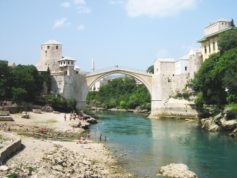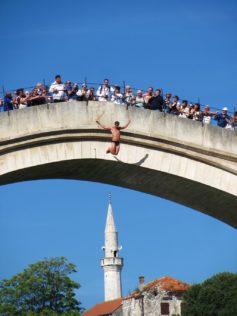(Penny Noyce, co-founder of Tumblehome Books, is the author or co-author of ten science books for kids. Her most recent book, Engineering Bridges: Connecting the World, will be released November 1, 2019.)
Stari Most
Stari Most: in English, the name evokes a starry sky on a clear night, one blanket of stars, a feeling of hope and peace. But in reality, the name means “Old Bridge” in Bosnian.
Stari Most, which gave the city of Mostar its name, was commissioned by Suleiman the Magnificent to replace a rickety wooden suspension bridge. When completed by Mimar Hayruddin in 1566, its 29 meters made it the widest stone arch in the world. The bridge lay at the heart of a city of bazaars and fields, mosques, churches, and synagogues.

But the bridge visitors see today is not the one built in the sixteenth century. That one was destroyed by shelling on November 1993, during one of the series of bitter wars in the former Yugoslavia, this one the war in Bosnia and Herzegovina. A Croatian general ordered his troops to batter the Old Bridge with sixty shells. The general later claimed the bridge had strategic importance, but others saw the act as one of deliberate cultural destruction—a way of trying to obliterate the memory of centuries of people living together in peace.
Not long after the bridge was destroyed, Spanish and Portuguese military engineers assigned to the UN Protection Force built a temporary bridge suspended from cables, not so different from the one Suleiman had replaced four and a half centuries earlier. After the war ended, UNESCO, the Aga Khan, and countries and people all over the world donated funds to rebuild the bridge using the same techniques and materials as the Ottoman bridge. Hungarian army divers even managed to haul up some of the original stones from the riverbed to use in the reconstruction.
Although stories say that eggs were used in the original mortar (the same is said of Prague’s Charles Bridge), that is one technique the Turkish company rebuilding the bridge did not embrace. The new Old Bridge opened on July 23, 2004. At once, young men of the town renewed the traditional annual leap into the cold Neretva. Since 1968, this summer leap has become a formal diving competition. So it’s a good thing that the Hungarian army divers had cleared away the rubble of war!

A bridge can symbolize many things: a passage to a new life, friendship, ingenuity, reaching across barriers or the courage to take a leap of faith. Stari Most, reconstructed, signals all of that and more. It stands as a symbol of hope. It demonstrated that the people of the world can come together, late and slowly but nevertheless determined, guided by their desire to heal divisions, bring reconciliation, and restore what once was lost. Mostar is now once again a multicultural city where diverse religious and ethnic communities live together in peace.
– Written by Pendred E. Noyce
Pre-order your copy of Engineering Bridges, suitable for age 12 and up, for 30% off using the coupon code “Thinc2019”








